Learn
- 19th century
- Romanticism
- Characterstics of Romanticism
- Goya
- Turner
- Realism
- Characteristics of Realism
- Homer
- Eakins

19th Century Art, Part I (1800 – 1900)
In this lesson and in the following lesson, we will be discussing art movements that occurred during the 19th century, from 1800 to 1900.
The 19th century was essentially the beginning of modern art. Art in the 19th century was greatly influenced by many things. First of all, the Industrial Revolution began and it created a class of wealthy businessmen. These businessmen became art collectors or contributed money to art museums and galleries. This allowed more artists to work full time and led to a number of art groups and artist colonies. It also led to the emergence of many new movements/styles of art. The most famous one of the 19th century was the Impressionist movement/style.
Paint manufacturing created several innovations. American painter, John Rand, invented the collapsible paint tube in 1841. Many new and vibrant colors were created although some were not very safe. In fact, emerald green, a favorite color of Vincent van Gogh, was so poisonous that it was marketed as Paris green and was used to kill rats in the sewers of Paris.

Collapsible paint tube
The arrival of photography, while initially helpful to artists, eventually led to the decline of portrait art, which became far less popular. The worldwide distribution of newspapers and inexpensive books created a demand for illustration and other forms of graphic art.
Sculpture changed as materials for sculpture began to cost more. No one could erect a monument without a commission and artists were now at the mercy of public opinion and city governments. Artists still worked with relief sculpture, bronze sculptures, marble, terracotta, porcelain, and plastic art. The term "plastic art" is derived from the word "plasticize" meaning "to mould." It describes any art form that involved modeling or moulding in three dimensions, and sculpture is the most common form. One of the most famous and outstanding plastic artists of the 19th century was August Rodin.
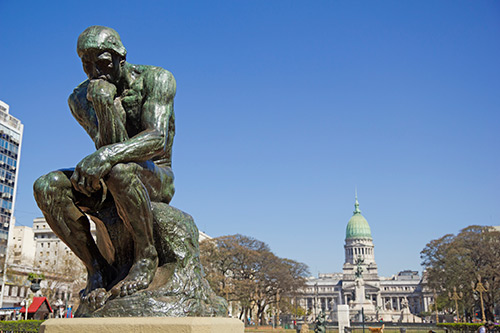
The Thinker by Auguste Rodin

Romanticism
Romanticism (1800 - 1840) was a cultural movement that began in Europe. It was a reaction to the Industrial Revolution, which occurred at the same time. This movement affected philosophical thinking, literature, music, and art. Romantic art lasted about forty years, and it focused on emotions, feelings, and moods of all kinds including spirituality, imagination, mystery, and intense, passionate feelings. The Romantic movement promoted creative intuition and imagination as the basis of all art. Romantic artists retained the academic traditions of their art.

Washington Crossing the Delaware by Emanuel Leutze, 1851

Characteristics of Romanticism
The characteristics of Romanticism include:
- Emotional emphasis – Artists expressed as much feeling and passion as they could in their work. For example, a landscape painting could evoke a mood by showing a crowd with expressions on every face; an animal painting could depict a certain trait of that animal. Portraits looked different; sitters would be given eyes that meant to mirror their souls, a smile, a frown, and a certain tilt of the head. The artists could portray their subjects in many different ways.
- Nature can change without warning – A prevalent theme in Romantic art is that nature could change direction at any time, and mortal people are no match for it. This is evident in the many examples of shipwrecks in Romantic paintings. There are a lot of paintings of blizzards, fires, thunderstorms, lightning strikes, floods, earthquakes, volcanoes, and biblical disasters.
- Current events – Viewers of Romantic paintings are able to gain knowledge of the story from the subject matter that they see in the painting. Artists took inspiration from current events. Not every work related back to current events, but when it did, the benefits were that the viewers were informed, and it increased the recognition of the artists who created them.
- Lack of a unifying style, technique or subject matter - Artists painted any mood that they wanted to paint during the Romantic period. Technique ranged from smooth as glass, highly monumental canvas to indistinct, watercolor washes. The execution of the technique was clearly up to the artist. Romantic artists would make statements in their artwork about how they felt on any given day. Themes could be religious, landscapes, revolutions, or peaceful beauty.
- Retained perspective, proportions, and symmetry – Romantic artists felt that the art of the Renaissance and other periods before them was too confining. However, they did keep some parts of these periods; they just ventured beyond, which seemed to have a sense of rationalism in them.
- Landscape painting – Landscape painting was the preferred genre of Romantic painters. They would paint solitary figures set in the countryside as well as Vanitas showing dead trees and overgrown ruins.
- Treatment of light and shade – Romantic artists borrowed the treatment of light and shade in their paintings directly from Baroque masters.
- Plein-air painting – This was spontaneous painting that was done outdoors. Romantic art included a return to nature.
- Belief in Goodness of humanity
- Promoted justice for all
- Looser and less precise brushwork
- Less conventional and highly personal approaches
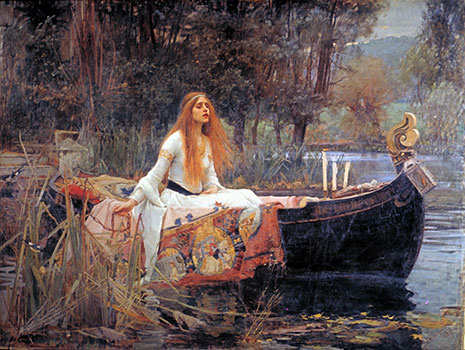
The Lady of Shalott by John Williams Waterhouse, 1888, is based on the poem of the same name by Alfred Lord Tennyson

Artist Spotlight: Goya
Born in a small village in Northern Spain, Francisco Goya (1746 - 1828) was the leader of the Romantic art movement in Spain. At the age of 14, he became the apprentice for a local painter named Jose Luzan who taught him to draw and thus began his illustrious career as an artist. He had a natural flair for works of irrationality, imagination, fantasy and terror. Goya's portraits, figurative drawing Figurative drawing is drawing of the human form in any of its various shapes and postures using any drawing media , watercolors, and prints all documented important historical events in Spain during the late 18th and early 19th century. Goya was a keen observer of everyday life and made sketches of everyday life where ever he went.
Goya's artwork documented important historical events in Spain during the late 18th and early 19th century. He was appointed as the official painter to the Spanish Royal court in 1789.
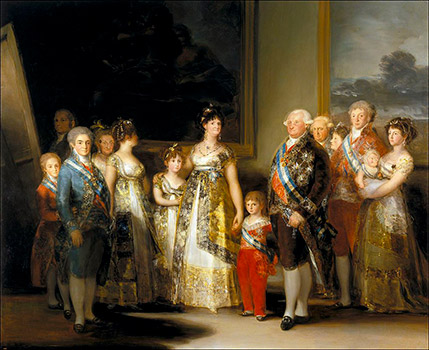
Charles IV of Spain and His Family by Goya, 1800-01
When he was 47 years old, he became seriously ill, which left him deaf and completely withdrawn from his family and friends. This isolation caused Goya to retreat into his own imagination. Thus, a new style emerged, one that leaned more toward satirical caricatures that mocked the Spanish authorities during the Spanish Inquisition. Drawings that he did during this time made him very unpopular with the authorities of the Inquisition. One of his greatest paintings commemorated the Spanish insurrection against the French troops in 1808, The Third of May, 1808. This painting, shown below, has been acknowledged as the first true painting of modern art.
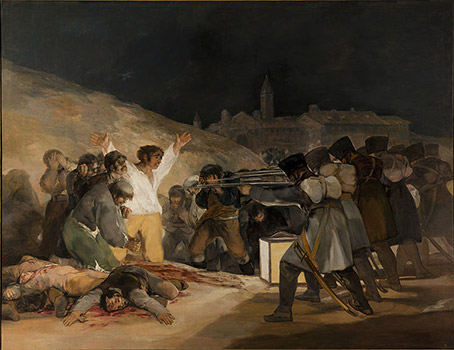
The Third of May, 1808 by Goya, 1814
Goya's work spans over 60 years. In 1824, frustrated with all the political upheaval in Spain, he went into exile in France. He lived as a recluse and slipped deeper into his fantasy world. He began to lose his eyesight and painted with a magnifying glass. He worked until his death in 1828 at the age of 82. Goya was a master portrait artist as well as a printer. His dramatic painting style influenced many 19th century artists.

Artist Spotlight: Turner
The son of a barber and wig maker, Joseph Mallord William Turner (1775 - 1851) was arguably the greatest of all English painters during the Romantic movement. His father taught him to read, and besides his study of art, that was his only education. By the time he was 13, he was selling his drawings in his father's shop. Turner was 14 when he was accepted into the London Royal Academy of Art. At the age of 15, one of his watercolors was accepted for exhibit at the Academy; this was a very rare honor for someone so young.
His paintings focused mostly on atmospheric effects than they did on detail. He was more concerned with the study of light in his paintings, and he did not want objects distracting from this focus. Turner was more concerned with how light played on clouds, water, skies, and fires in his paintings. In his painting Rain, Speed and Steam, shown below, it was said that he actually stuck his head out of a moving railway carriage to see what the rain would look like while the train was moving. He even tied himself to the mast of a ship in a storm in order to experience the stormy sea.
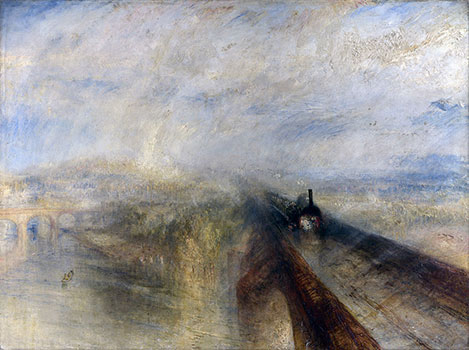
Rain, Steam, and Speed - The Great Western Railway by Turner, 1844
Turner was described as the only artist who could "most stirringly and truthfully measure the moods in Nature." He is actually just as popular in the 21st century as he was in the 19th century.
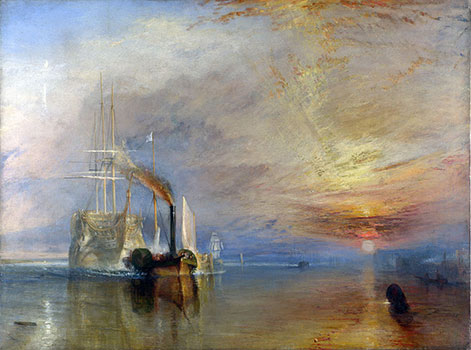
The Fighting Temeraire tugged to her last berth to be broken up by Turner, 1838

Realism
The art movement Realism (1840 - 1880) spread quickly throughout Europe and America. It revolted against the exaggerated themes of Romanticism. Artists began to explore the reality of everyday life. Realists depicted the world as it actually appeared. They painted everyday subjects and people, and they didn't try to interpret it or add emotional meaning to their paintings. It was a way to express the world with photographic accuracy. An artist's highest accomplishment was that they were able to faithfully represent life as it happened around them.
The invention of photography in 1840 helped to spur the Realism movement. There was very little sculpture or architecture in this movement. Realism spread to all genres including history painting, portraits, genre painting, and landscapes. Realism had a huge influence on art during this time period and beyond. It was adopted into the mainstream of painting and became less of a movement and more of an artistic style.
Realistic artists captured events of everyday life, portraying real and typical contemporary people with truth and accuracy. They did not avoid the unpleasant aspects of life. They depicted people of the middle and lower classes in situations in ordinary life.
A favorite subject matter of artists was typically genre scenes of rural and urban working class life, scenes of street-life, cafes, and nightclubs. There was increased frankness in the depiction of the human body. Artists wanted people to see, touch, taste, and feel the objective truths of life that were around them. Works of art were true to life.
Artists focused on the world around them, particularly problems like poverty and political repression. They exposed the gritty details of contemporary life.
Realism artists used lighting to recreate a scene's natural lighting and time of day. By actually using light sources to provide illumination, an artist might use the light of the day, a fireplace, a lamp, or a window.
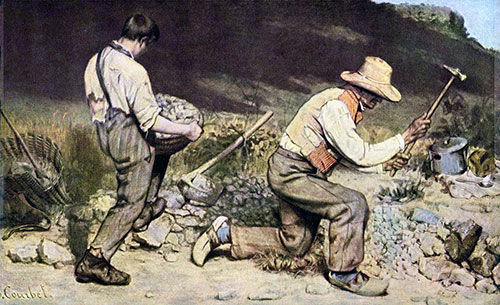
The Stonebreakers by Gustave Courbet, 1849

Characteristics of Realism
The characteristics of Realism include:
- Emphasis on the Everyday – Realistic artists captured events of everyday life and to portray real and typical contemporary people with truth and accuracy. They did not avoid the unpleasant aspects of life. They depicted people of the middle and lower classes in situations in ordinary life.
- Favorite subject matter – genre scenes of rural and urban working class life, scenes of street-life, cafes and nightclubs, increased frankness in the depiction of the human body. They wanted people to see, touch, taste and feel the objective truths of life that were around them.
- The World around them – artists focused on the world around them, particularly problems like poverty and political repression. They exposed the gritty details of contemporary life. They had a concern for human rights.
- Photographic Accuracy – Realism sought to capture everyday life in photographic accuracy down to the correct clothing, setting and quality of light. Works of art were true to life.
- Absolute Objectivity – Realism created honest, real life situations without the embellishments and superimposed ideas of artist of previous movements. The natural world contained its own eloquence and symbolism and could be shown realistically through the artist's works.
- Timing and Light - Realism artists used lighting to recreate a scenes natural lighting and time of day. By actually using light sources to provide illumination an artist might use the light of the day, a fireplace, a lamp, or a window.
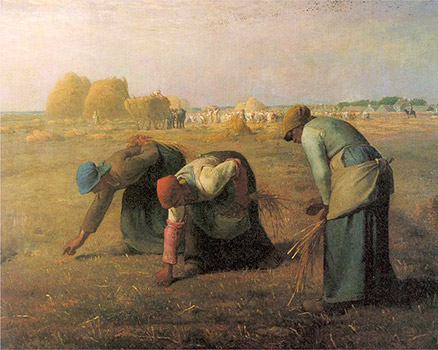
The Gleaners by Jean Francois Millet, 1857

Artist Spotlight: Homer
Born in Boston, Massachusetts, Winslow Homer (1836 - 1910) was one of America's most famous painters. He developed an early taste for drawing, and wherever he went, he sketched pictures of his surroundings that told a story. His ability to capture city life in his drawings caught the attention of the editors for Harper's Weekly magazine.
Homer began to use watercolor in 1873 and he became a master of this medium. His unique style influenced generations of American painters because of its direct and energetic representation of man's struggle against nature. His storytelling through his painting and his mastery of several media in painting and printmaking helped him become one of the most influential realists of his time.
Watch the video "Breezing Up (A Fair Wind)," 1873–1876, Winslow Homer (2:20) to learn more about him and his painting Breezing Up.
See some of Homer's work below:
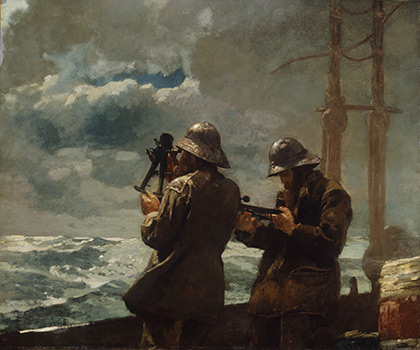
Eight Bells by Homer, 1886
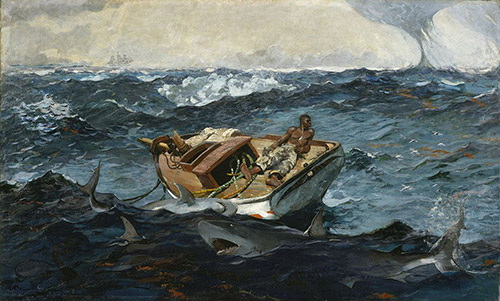
The Gulf Stream by Homer, 1899

Artist Spotlight: Eakins
Born in Philadelphia, Pennsylvania, Thomas Cowperthwait Eakins (1844 - 1916) studied art at the Pennsylvania Academy of the Fine Arts. Later, he studied anatomy at Jefferson Medical College. From 1866 - 1869, Eakins studied at the French Academy in Paris; then, he went to Spain to study the great Spanish Masters of Realism. He was considered one of the best portrait artists of the 19th century and one of the greatest painters of figure painting in America.
He devoted almost all his attention to the aspects of drawing the human figure, which included figure drawing from life, anatomical studies of the human and animal body, surgical dissection, the fundamentals of form as well as studies in linear perspective involving mathematics. He also encouraged his students to use the newly developed process of photography as an aid to study the body and to study motion.
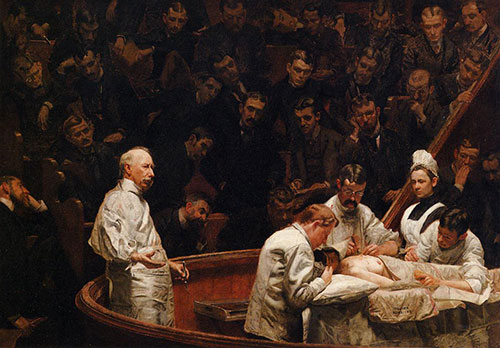
The Agnew Clinic by Eakins, 1889
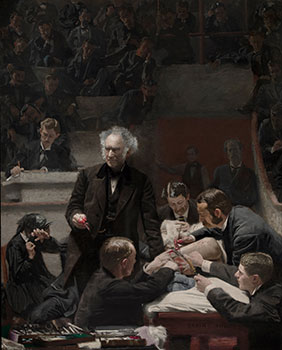
Portrait of Dr. Samuel D. Gross is also called The Gross Clinic is by Eakins, 1875
Eakins was an avid user of the camera. This can be seen in his works; however, it caused criticism about his artistic methods. Eakins' paintings show an outstanding control of perspective, human anatomy, mechanical drawing and the study of the human body in motion. In all of his realistic paintings, the human figure is central to his composition. His extensive use of tenebrism caused his scenes to be lively and have feeling. Eakins' work is now considered to be the finest example of figurative realism in American modern art.
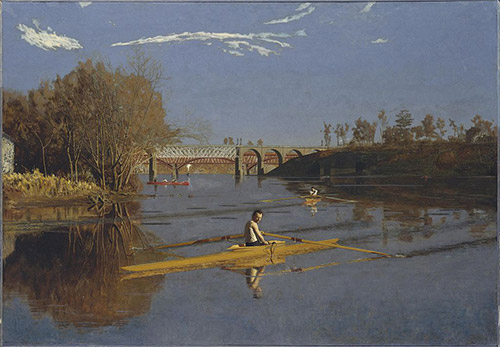
The Champion Single Sculls is also called Max Schmitt in a Single Scull by Eakins, 1871

